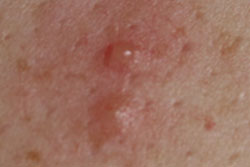Shingles is a rash caused by the same virus that causes chicken pox. Dr Joe Kosterich talks about shingles, including what it is, how it’s caught, who gets it, what its symptoms are, and how to treat it.
 Shingles is a condition which everybody sort of knows the name of but not many people really know that much about it. Interestingly, the way shingles works is more similar perhaps to cold sores than anything else. Whilst it’s caused by the chicken pox virus the actual shingles – and we’ll get to what shingles is in a moment – comes about from a reactivation of the virus. Much like if people have cold sores then at some point the virus can reactivate and you get the sores coming out again, the chicken pox virus can reactivate (having sat dormant in your system), come out and cause a rash.
Shingles is a condition which everybody sort of knows the name of but not many people really know that much about it. Interestingly, the way shingles works is more similar perhaps to cold sores than anything else. Whilst it’s caused by the chicken pox virus the actual shingles – and we’ll get to what shingles is in a moment – comes about from a reactivation of the virus. Much like if people have cold sores then at some point the virus can reactivate and you get the sores coming out again, the chicken pox virus can reactivate (having sat dormant in your system), come out and cause a rash.
Shingles is also much rarer than cold sores. The only people who are going to get shingles are those who’ve had chicken pox, or exposure to the chicken pox virus, at some time in the past. It could have been when you were two-years-old and the shingles can come out when you are 90. It just means that it has been there at some point in your life. The virus sits dormant on a nerve ending; most commonly it’s somewhere around the back, somewhere on the vertebral column.
The typical symptoms of shingles start with a tingling or burning sensation on the skin. This will most typically be somewhere around the centre of the body – around the chest, back or abdomen – although it can be on the head or neck. So generally you get some burning or tingling for maybe a day or a couple of days. After that, some blisters will come out. There may be a few blisters, there may be quite a lot, but they will follow what is called a dermatome. A dermatome is the area of the skin that is served by one level of nerve from the back. For example, in the thoracic or mid back, you’ve got twelve nerves on each side. If shingles affected the T6, or the thoracic six, vertebral outlet, then you would get it in the T6 dermatome which will be around the nipple, give or take a couple of centimetres. If people get shingles again it will generally affect exactly the same area, much like how cold sores affect either the upper or lower lip on the left or right side.
When the rash comes out, it will look like some blisters and it will follow a pattern. You may get a few blisters the first day and a few more may come out over the next few days. Generally it is not a completely “filled in-rash”: it won’t cover an entire arch but there will be parts of it.
There is no specific cure as such for shingles. There are some medications that can be used that will shorten the course a little bit. For them to be effective you do need to start on them within 72 hours of the rash coming out. So if you do get a shingles-type rash or suspect that that’s the case, then it’s a good idea to go down and see your doctor. Do be aware though that the tablets are not a cure but they can shorten the course. Creams that can just ease the symptoms a little bit, most of which are available over-the-counter from the chemist, and simple analgesics, or pain killers, can provide some relief.
Shingles will run its course. For the vast majority of people it will all be over and done with within seven to ten days. Some people will get mild doses; it won’t be particularly pleasant but it won’t cause a lot of problems. For some people it can be more acutely painful and that can lay people up for a period of time. Fortunately it’s rare that some people develop what is called a postherpetic neuralgia and they can continue to get a pain along that area for a period of time after the shingles has gone. So even after the rash has gone, some people may experience pain and there are some specific tablets that can be used for that. Fortunately, it is very rare.
When do people tend to get shingles? Similar to cold sores, if people are a bit run down – maybe if they’ve had some other sort of illness or if they are particularly stressed, or if they are extremely tired, or if they have some other illness – these are the times when the shingles may re-emerge. Sometimes there is no apparent reason that you can put it down to.
To sum up, shingles is not that common. Certainly there are people out there with it, but it doesn’t tend to recur that frequently which is good news for people if they have had it. There is no specific cure but there is treatment available. If you suspect that you do have shingles or you have a rash that you are not sure about, then obviously go along and see your doctor and take things from there.
More information
 |
For more information on chicken pox and related conditions, as well as some useful videos, see Chicken Pox, Shingles and Postherpetic Neuralgia. |
All content and media on the HealthEngine Blog is created and published online for informational purposes only. It is not intended to be a substitute for professional medical advice and should not be relied on as health or personal advice. Always seek the guidance of your doctor or other qualified health professional with any questions you may have regarding your health or a medical condition. Never disregard the advice of a medical professional, or delay in seeking it because of something you have read on this Website. If you think you may have a medical emergency, call your doctor, go to the nearest hospital emergency department, or call the emergency services immediately.







